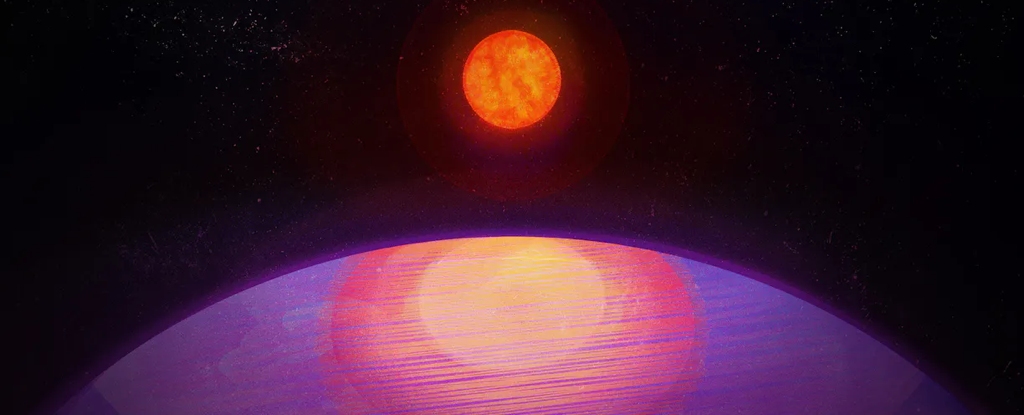
Picture yourself as a farmer, searching for eggs in the chicken coop. However, instead of a regular chicken egg, you come across an ostrich egg, significantly larger than anything a typical chicken could lay.
It’s akin to the surprise a team of astronomers experienced when they identified a colossal planet, weighing over 13 times more than Earth. This discovery occurred orbiting a cool, faint red star, which is just nine times less massive than the Sun, earlier this year.
The diminutive star, known as an M star, is not only smaller than the Sun in our solar system but also significantly less luminous, shining only at 100 times less intensity. According to expectations, a star of this size shouldn’t possess enough material in its disk for the formation of a planet as massive as the one discovered.
The Habitable Zone Planet Finder
In the last ten years, our team developed and constructed a new device at Penn State with the ability to capture the light emitted by these faint, cool stars. This instrument operates at wavelengths beyond what the human eye can perceive, specifically in the near-infrared range, where these cool stars predominantly emit their light.
Affixed to the 10-meter Hobby-Eberly Telescope in West Texas, our tool, named the Habitable Zone Planet Finder, can precisely gauge the slight shift in a star’s speed caused by the gravitational pull of a planet. This method, known as the Doppler radial velocity technique, proves highly effective in identifying exoplanets.
The term “Exoplanet” is derived from the words extrasolar and planet. It encompasses any planet-sized object orbiting a star other than our Sun.
Three decades ago, observations using the Doppler radial velocity technique led to the identification of 51 Pegasi b, the initial confirmed exoplanet circling a star similar to our Sun. In the years that followed, astronomers, including ourselves, have enhanced and refined this method for detecting exoplanets.
The aim of continually improving and accurate measurements is significant: facilitating the identification of rocky planets within habitable zones – the areas around stars capable of sustaining liquid water on the planet’s surface.
At present, the Doppler technique lacks the capability to identify Earth-mass planets within the habitable zones of stars resembling the Sun in size. However, M stars, being cool and dim, exhibit a more noticeable Doppler signature for an Earth-sized planet.
The reduced mass of these stars results in a stronger gravitational tug from the orbiting planet. Additionally, their lower luminosity causes a habitable zone closer to the star, leading to a shorter orbit, thereby making the planet easier to detect.
Our team developed the Habitable Zone Planet Finder specifically to uncover planets around these smaller stars. The recent unexpected discovery, featured in the journal Science, involves a massive planet closely orbiting the cool, dim M star LHS 3154 – akin to finding an ostrich egg in the chicken coop.
LHS 3154b: The planet that should not exist
Planets take shape within disks consisting of gas and dust. These disks attract and gather dust particles, which gradually enlarge into pebbles. Over time, these pebbles join forces to create a sturdy planetary core.
After the establishment of the core, the planet can exert gravitational force, attracting both solid dust and nearby gases like hydrogen and helium. However, a considerable amount of mass and materials is essential for this process to be successful. This method of planet formation is termed core accretion.
For a star with as low a mass as LHS 3154, which is only nine times less massive than the Sun, it is expected to possess a correspondingly lightweight planet-forming disk.
A standard disk surrounding a star with such low mass is not expected to contain sufficient solid materials or mass to generate a core substantial enough for the creation of such a planet.
Based on our team’s computer simulations, we deduced that the planet in question requires a disk at least 10 times more massive than typically estimated from direct observations of disks forming planets.
Another theory of planet formation, gravitational instability – involving the direct collapse of gas and dust in the disk to form a planet – also faces challenges in explaining the creation of such a planet without a highly massive disk.
Planets around the most common stars
Cool and dim M stars represent the most prevalent stars within our galaxy. In the realm of DC comics, Superman’s home planet, Krypton, revolved around an M dwarf star.
Astronomers have found, through observations made with the Habitable Zone Planet Finder and other tools, that large planets in proximate orbits around the most massive M stars are at least 10 times less frequent than those around stars similar to the Sun.
Furthermore, there have been no reported instances of such massive planets in close orbits around the least massive M stars – until the revelation of LHS 3154b.
Gaining insights into the formation of planets around our cooler neighboring stars is crucial for comprehending the general process of planet formation and the development of rocky worlds around the most abundant types of stars. This avenue of research also holds the potential to aid astronomers in assessing the suitability of M stars to support life.
Read the original article.





